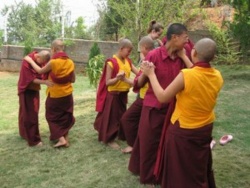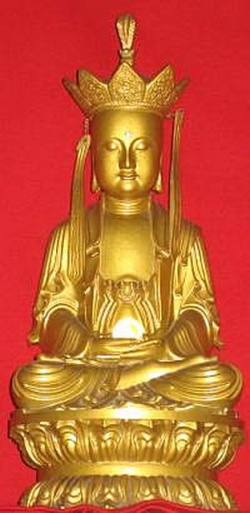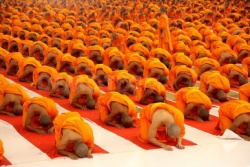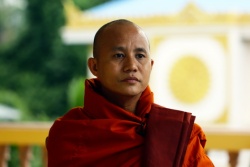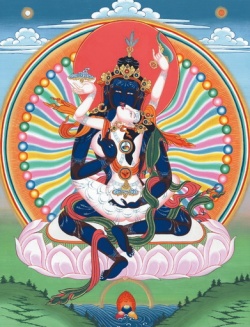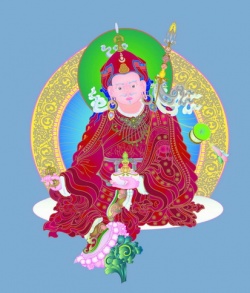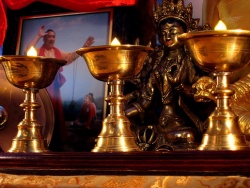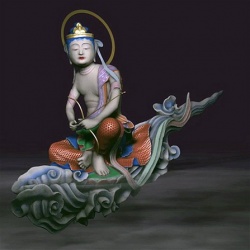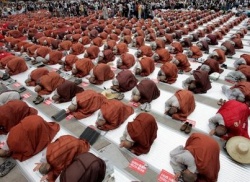Three Bodies Doctrine (Vedanta)
According to Sarira Traya, the Doctrine of the Three bodies in Hinduism, the human being is composed of three sariras or "bodies" emanating from Brahman by avidya, "ignorance" or "nescience".
They are often equated with the five koshas (sheaths), which cover the atman.
The Three Bodies Doctrine is an essential doctrine in Indian philosophy and religion, especially Yoga, Advaita Vedanta and Tantra.
The three bodies
Karana sarira or the causal body is merely the cause or seed of the subtle body and the gross body.
It has no other function than being the seed of the subtle and the gross body. It is nirvikalpa rupam, "undifferentiated form".
It originates with avidhya, "ignorance" or "nescience" of the real identity of the atman, instead giving birth to the notion of jiva.
Swami Sivananda characterizes the causal body as "The beginningless ignorance that is indescribable".
Siddharameshwar Maharaj, the guru of Nisargadatta Maharaj, also describes the causal body as characterized by "emptiness", "ignorance", and "darkness".
In the search for the "I am", this is a state where there is nothing to hold on to anymore.[note 1]
Ramanuja concludes that it is at this stage that consummation of the atman with the Paramatman is reached and the search for the highest Purusa, i.e., of Ishvara, ends.
According to other philosophical schools, the causal body is not the atman, because it also has a beginning and an end and is subject to modification.
Shankara, not seeking a personal god, goes beyond Anandamaya Kosha in search of the transcendent Brahman.
The Indian tradition identifies it with the Anandamaya kosha, and the deep sleep state, where buddhi becomes dormant and all concepts of time fail, although there are differences between these three descriptions.
The causal body is considered as the most complex of the three bodies. It contains the impressions of experience, which results from past experience.
Suksma sarira - subtle body
article: Subtle body
Suksma sarira or the subtle body is the body of the mind and the vital energies, which keep the physical body alive. Together with the causal body it is the transmigrating soul or jiva, separating from the gross body upon death.
The subtle body is composed of the five subtle elements, the elements before they have undergone panchikarana, and contains:
sravanadipanchakam - the five organs of perception: eyes, ears, skin, tongue and nose
vagadipanchakam - the five organs of action: speech, hands, legs, anus and genitals
pranapanchakam - the five-fold vital breath: Prana (respiration), Apana (evacuation of waste from the body), Vyana (blood circulation), Udana (actions like sneezing, crying, vomiting etc), Samana (digestion)
manas
Buddhi, the Intellect, discriminating wisdom
Other Indian traditions see the subtle body as an eighth-fold aggregate, placing together the mind-aspects and adding avidhya, kamah and karma:
buddhyadicatustayam (buddhi, manas, ahamkrti, citta),
avidya (adhyasa, super-imposition),
kamah (desire),
karma (action of the nature of dharma and adharma).
In samkhya, which does not acknowledge a causal body, it is also known as the linga-sarira.
It puts one in the mind of the atman, it reminds one of the atman, the controller. It is the beginningless limitation of the atman, it has no beginning like the Sthula sarira.
The "dream state" is a distinct state of the subtle body, where the buddhi shines itself owing to memory of deeds done in the waking state. It is the indispensable operative cause of all the activities of the individual self.
Sthula sarira - gross body
See also: Rūpa
Sthula sarira or the gross body is the material physical mortal body that eats, breathes and moves (acts).
It is composed of many diverse components, produced by one’s karmas (actions) in past life out of the elements which have undergone panchikarana i.e. combining of the five primordial subtle elements.
It is the instrument of Jiva’s experience, which, attached to the body and dominated by Ahamkara, uses the body’s external and internal organs of sense and action.
The Jiva, identifying itself with the body, in its waking state enjoys gross objects. On its body rests man’s contact with the external world.
The Sthula sarira’s main features are Sambhava (birth), Jara (old age or ageing) and Maranam (death), and the "Waking State".
The Sthula sarira is the anatman. The gross bodies, the subtle bodies and the causal worlds make one vast universe.
Correlations with other models
The Taittiriya Upanishad describes five koshas, which are also often equated with the three bodies.
The three bodies are often equated with the five koshas (sheets), which cover the atman:
[Sthula sarira]], the Gross body, also called the Annamaya Kosha
Suksma sarir', the Subtle body, composed of:
Pranamaya Kosha (Vital breath or Energy),
Manomaya Kosha (Mind),
Vijnanamaya Kosha (Intellect)
Karana sarira, the Causal body, the Anandamaya Kosha (Bliss)
Four states of consciousness and turiya
The Mandukya Upanishad describes four states of consciousness, namely waking consciousness, dream, and deep sleep, and turiya, the base-consciousness.
Waking consciousness, dream, and deep sleep are equated with the three bodies, while turiya is a fourth state, which is equated with atman and purusha.
Turiya
article: Turiya See also: Purusha, Tathagatagarbha and Sunyata
Turiya, pure consciousness, is the fourth state. It is the background that underlies and transcends the three common states of consciousness.
In this consciousness both absolute and relative, Saguna Brahman and Nirguna Brahman, are transcended.
It is the true state of experience of the infinite (ananta) and non-different (advaita/abheda), free from the dualistic experience which results from the attempts to conceptualise ( vipalka) reality.
It is the state in which ajativada, non-origination, is apprehended.
Four bodies
Siddharameshwar Maharaj, the guru of Nisargadatta Maharaj, discerns four bodies, by including turiya or the "Great-Causal Body" as a fourth body.
Here resides the knowledge of "I am" that cannot be described, the state before Ignorance and Knowledge, or Turiya state
Application in Indian philosophy
The three bodies are an essential part of the Yoga physiology. Yoga aims at controlling the vital energies of the bodies, thereby attaining siddhis (magical powers) and moksha.
Atma vijnana
According to the Advaita Vedanta tradition, knowledge of the "self" or atman can be gained by self-enquiry, investigating the three bodies, and disidentifying from them.
It is a method which is well-known from Ramana Maharshi, but also from Nisargadatta Maharaj and his teacher Siddharameshwar Maharaj.
By subsequently identifying with the three lower bodies, investigating them, and discarding identification with them when it has become clear that they are not the "I", the sense of "I am" beyond knowledge and Ignorance becomes clearly established.
In this investigation the three bodies are recognized as not being anatman. Theosophy
The later Theosophists speak of seven bodies or levels of existence that include Sthula sarira and Linga sarira.

